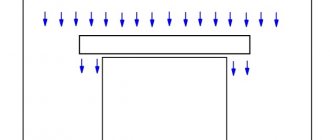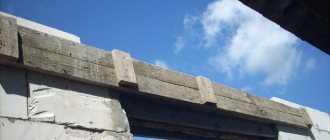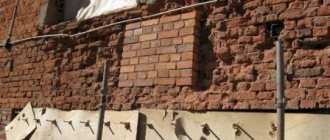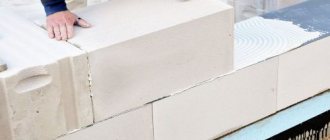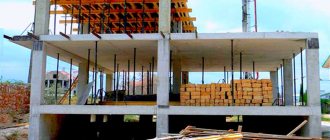Load-bearing walls are called that because they bear the load from the floors, upper floors and roof. It can be very significant, so any violation of the integrity of the structure leads to the risk of the building collapsing or being declared unsafe. For this reason, an opening in a load-bearing wall cannot be made without first strengthening it, and in most cases it is generally prohibited by law and construction standards, especially when it comes to multi-story buildings.
Cutting an opening in the outer wall of a private house Source almaznoe-burenie-moskva.ru
Instructions for constructing an opening in a load-bearing brick wall
Korovin Sergey Dmitrievich
Master of Architecture, graduated from Samara State University of Architecture and Civil Engineering. 11 years of experience in design and construction.
Sometimes, for redevelopment in an apartment or private house, it is necessary to make a new door or window opening. Creating an opening in the load-bearing wall of an apartment brick building is not the easiest task. Things are easier with redevelopment in a private house, here everyone is their own boss.
What is a doorway? This is a hole in the wall intended for installing entrance units. The fixed fixed element in the inter-wall space is called a door frame. Often an arch is made as a decorative element of the interior.
Step-by-step instruction
There is nothing complicated in the process itself, and you should be interested not in how to do it, but in how to do it correctly. A new doorway in a brick wall can weaken the structure if the sequence of work is not followed.
First you need, oddly enough, to mount a new jumper. To do this, you should knock out a place under it half a brick deep. I would like to remind you that the minimum support for the lintel is 20 cm.
If you have a block lintel (standard concrete) of the right size and people to lift it, great. Reinforced lintels are used in load-bearing walls; they weigh a lot. If this is not possible, the jumper is made from a channel. Try to make the recess for the jumper as suitable in size as possible, especially at the top.
In load-bearing walls, the channel height cannot be less than 200 mm.
For one opening you will need two lintels, and in each of them you will need to make holes for tightening bolts at a distance of no more than 500 mm from each other. The holes are made clearly opposite each other.
Having punched the space for the jumper on one side, punch holes all the way through in the places where the tie bolt will be. It may be better to do this with impact drilling - most rotary hammers have this function. After this, you can begin to punch out a place for the second jumper.
Now you should put both jumpers in place and tighten them with bolts or studs. It will be more convenient to work together.
Once the jumper is in place, the support posts can be removed; the overlap is not going anywhere.
The next stage is marking and cutting the contours of the opening. Marking is done using a marker, tape measure and level. You can cut through the outline with a grinder or a gas cutter. The smoother the cut, the easier it will be for you to carry out further strengthening of the frame and finishing work.
Having cut through the outline, you can begin dismantling. This is done with a hammer drill. If you don't need old brick, feel free to use a pneumatic jackhammer, this will make the job go faster. If you need to fill an old doorway with knocked out bricks, work more carefully, knocking out along the seam.
It is more convenient to make the final adjustment of the opening not with a simple drill, but with a small spatula - this way you can knock down small defects without making cracks in the wall.
Construction of a doorway in a load-bearing brick wall
Before starting work, you must contact a specialist who will make a demonstration project with all calculations based on the client’s wishes. To implement the project, significant costs are required, which start from an amount of 30 thousand rubles. So when you get down to business, you need to consider a lot. Independent work on constructing a doorway will help the owner save money - it will cost approximately 15 thousand rubles .
Construction of a new opening
When constructing an interwall opening, it is recommended to take into account the following points:
- it must comply with building codes;
- It is advisable to place the hole in the central part of the supporting structure;
- it is necessary that the top part coincides with the cement seam of the masonry;
- the space between walls up to 0.9 m wide does not require reinforcement operations.
When creating an inter-wall space in a supporting wall, you need to properly create the reinforcement. When changing the structure of the walls, it is important to ensure the safety of the lives of other residents of the apartment building and the preservation of the structure of the building itself.
Work order
First of all, you need to decide where to organize additional space for entry and exit. It all starts with markup . You need to decide on the width of the hole, and then begin to determine its future location with a pencil. You need to measure the distance from the outer wall and make a mark - from here we begin to draw the outline of the future interior space.
A thick wall structure is being cut on both sides, so markings will be necessary on the reverse side as well.
For their exact match, it is necessary to drill several holes according to the pencil markings (Fig. 1). And then on the other side connect all the holes with a pencil line.
The above-described manipulations should be carried out using a building level, a triangle and a ruler.
Since we will create the space in the load-bearing wall of a brick house, it is necessary to take care of auxiliary partitions and lintels in advance (Fig. 2).
Rice. 2
Working with reinforced concrete wall
Concrete walls are made load-bearing. Therefore, how to make an opening in such a reinforced concrete wall so as not to destroy the building is indicated in the regulatory documents. It is important to make the correct calculation of the reinforcing frame. It is better not to do such work yourself to avoid unpleasant consequences.
Such changes to the supporting structure require special permission. It is necessary to submit a work plan and drawings of the future redevelopment of the premises. Even the smallest nuances are taken into account in the documents. Only in this case can you count on approval of the work by the architectural organization. After receiving permission, you can begin work.
First, the future passage is marked. Moreover, it should be done on both sides of the wall. To ensure that the lines coincide, grooves are drilled in the corners of the wall and, starting from them, marking lines are drawn. Then holes are drilled around the perimeter of the opening, in increments of 30 mm.
For processing concrete walls, it is advisable to have diamond saws. They handle concrete surfaces easily. Without them, such work will take a lot of time and become labor-intensive.
The opening is framed in the broken wall. For this, a metal channel is used. You can install corners that are pre-welded to each other.
Channel reinforcement of the opening
Removing a section of wall
Before starting work, it is necessary to free the supporting wall structure from the layer of plaster along the drawn line so that the seams of the masonry are visible. However, it is necessary to remove the plaster with extreme caution, because most likely there is wiring located underneath it - damage can lead to the failure of the entire power supply system.
When the seams at the site of the future empty space are visible, you can begin to work. You need to start removing bricks from the very top. First, the top row of bricks is removed, which will be the width of the entire door space . A jumper is inserted here on which the structure will be supported.
Next, more holes are made above the jumper. It is necessary to install a beam into the resulting hole, which will act as a support. The support beam must be supported with a jack so that the structure does not collapse during operation. The beam and jack will support the weight of the entire wall structure (Fig. 3).
Channel lintel
Then all holes are lubricated with concrete solution. After the concrete mixture has dried, you can continue working on knocking out bricks.
The structure should be strengthened if the door space is more than one meter wide.
To protect the floor from falling bricks, it is necessary to make a flooring from boards. Bricks should be removed with diamond drills to minimize damage to the wall structure.
Violation of the technology for removing bricks can lead to weakening of the structure, its premature wear and deformation.
It should be noted that the space under the door must be 10-20 centimeters larger than the door or window frame. This gap can be filled with foam.
Strengthening the opening
Strengthening work takes the maximum amount of time, as it is carried out painstakingly. Organized empty space under a door or arch must be reinforced with channels . It is advisable to use a channel jumper with vertical posts. Channels are mounted on both sides, which are screwed into the previously installed wooden lintel using bolts (Fig. 4).
Rice. 4
If the space in the wall structure is large, then it is reinforced not only in the upper part, but also on the sides (Fig. 5).
Rice. 5
How to determine a load-bearing wall in a brick house?
The most basic way to determine the supporting wall is to familiarize yourself with the floor plan of the living space. Such a plan must be included in the registration certificate or house register. To understand diagrams and drawings, you need to have some drawing skills. Experience in construction would be helpful. Then you can easily distinguish a supporting wall from a regular partition.
Typically, interior walls are no more than 18 centimeters thick. The smallest thickness of the supporting wall is 38 centimeters - a masonry of three bricks . Four-brick masonry is possible, which forms a wall 51 centimeters thick. Often the thickness of the walls in brick houses is 64 centimeters - five-brick masonry (Fig. 6).
If the plan could not be found, then you should use the general rules for determining load-bearing walls in a house:
- if the walls face the street, we can definitely say that they are supporting;
- walls shared with neighbors;
- wall thickness more than 380 mm, as mentioned earlier;
- walls facing the landing.
Exterior finishing
After completing the work on forming the opening in the brick load-bearing wall, everything must be decorated decoratively (Fig. 7) . What is needed for this? First of all, you need to decide on the choice of finishing material. Whether it will be wood, plastic or decorative stone – it’s up to you. Next, you need to show a little imagination and create decorative elements in the formed space of the brick wall.
Rice. 7
For self-cladding, you should have basic knowledge in the field of finishing work, and you also need to have special tools.
If you need to decorate the space for a door without having one, then you should use additional boards. This will add elegance to your new room decor and add sophistication to the interior. You can create such a cladding yourself.
The opening made in the form of an arch looks beautiful. As a rule, arches come in round or pointed shapes. To decide on the shape of the arch for the client, check out the design catalogs. The most common today is the Byzantine and Greek style. In some cases, the arch can be made with lighting.
Design of an opening in a load-bearing wall.
Our company is carrying out a project to strengthen an opening in a load-bearing wall and has the appropriate SRO approval for this. To order an opening project, call us by phone. The cost of the project per opening is 20,000 rubles. Production time is 5 working days. Below are examples of drawings and calculations for strengthening openings from our projects. Our company also provides services for coordinating such openings with the responsible authorities. If the wall is load-bearing, then when constructing any openings in it, the openings must be reinforced with metal structures.
Types of services and how much they cost
Using diamond cutting, you can make cuts in brick, concrete, reinforced concrete walls.
The cheapest cut is made in brickwork. The cost directly depends on the thickness of the wall. Punching a standard hole 2100x900 mm in a wall of 0.5 bricks costs on average from 3,500 rubles. Cutting 2.5 bricks is estimated higher, from 20,000 rubles. In addition, services for strengthening the supporting structure using a channel or angle and removal of construction waste are additionally paid. For the manufacture of non-standard openings, specialists charge more.
A hole in a concrete wall is also made with a diamond cutter. Concrete partitions come in different thicknesses, which directly affects the cost of the final work. When punching a concrete wall 20-40 cm thick, specialists use a wall saw with a water cooling system. After cutting, they disassemble the concrete by hand. Thicker partitions require the use of perforation cutting. A meter of cutting on concrete is estimated at 1000-1200 rubles.
A reinforced concrete wall is considered the strongest. The work of punching it is the most expensive. For 1 meter of cutting, specialists charge from 1,200 rubles.
Strengthening openings in brick walls.
When making an opening in a brick wall, it is enough to confine yourself to installing a new lintel:
Reinforcing an opening in a load-bearing brick wall.
In brick walls, openings are reinforced with a channel. On both sides of the load-bearing wall, grooves are cut at the required height for these channels. The lower boundary of the groove should run along the horizontal seam of the masonry so that the future lintel rests on a solid, untouched brick, otherwise it may not withstand the crushing and crumble in the future. After installing the grooves, channels are inserted into them on both sides and tightened with pins. The support length of the channels is usually 250-300 mm, it is determined either by calculation or from a table of standard openings. This table can be found in the book “Some Issues in the Repair and Reconstruction of Buildings” by V.T. Grozdova. It discusses in detail the strengthening of a doorway in a load-bearing wall for brick houses. After installing the lintel, the opening itself is cut out in small pieces. Reinforcement or plates are welded to the lower flanges of the channel, after which they are plastered over a metal mesh. After plastering the wall, the strengthening of the doorway is in no way noticeable.
If, when constructing an opening, a small partition remains (at least 400 mm), then as a rule (determined by calculation) it is taken into a metal frame:
Project for strengthening an opening in a load-bearing wall with compression of a brick wall.
In what cases is permission required?
Strengthening finished windows and doors does not apply to reconstruction. Such work does not require permission from government agencies. If you want to remodel and create a new opening in the walls, you will need to complete paperwork. Otherwise, such work may result in administrative liability.
You must first consult with relevant specialists. It is difficult to obtain permission for old houses due to dilapidation. They may not withstand reconstruction. To make an arch in the load-bearing wall of a brick house, an additional window or door, you need to find out the following points:
- house layout project;
- the ratio of the expected dimensions of the new hole and the load-bearing brickwork;
- technical characteristics of the structure and its elements (floors and roofing);
- thickness of the load-bearing wall and its strength.
How to remodel a home and make openings in accordance with legal regulations:
- First of all, you need to contact the BTI and write an application for permission to make additional improvements to the house using additional openings.
- Housing workers assess the technical characteristics of the building and the possibility of making design changes.
- Next, the owner receives a notification about the prohibition or permission of repair work.
If the administrative authorities have given consent, the home owner can contact the company carrying out the project development work. Architects will select the optimal solution for a specific building.
Redevelopment of a house may take a long time, since the approval process and drawing up a project can take up to 3 months.
The design documentation describes in detail the technique of punching openings in the load-bearing walls of a brick house. For each building the project is selected individually. It contains the following information:
- recommendations for carrying out work;
- technology and consistency;
- strengthening of structures.
For private homes, you can use a hammer drill and a jackhammer, but laser cutting is considered the safest and most effective method.
Strengthening the opening in a monolithic and panel wall.
There are several ways to strengthen such openings:
Strengthening the opening in the load-bearing wall of panel and monolithic buildings.
However, the most common way is to reinforce the doorway with a corner in the form of a frame:
Strengthening the openings with a metal frame made of corners.
An opening in a load-bearing wall with reinforcement in this case is performed in the following sequence. Before constructing the opening, temporary wooden posts are placed in the spacer with the ceiling or formwork posts are used for these purposes. The grooves are cut out for the frame posts and the lintel. The corners of the rack are placed in the design position, and part of the shelf is cut off at the corner of the jumper, installed and welded to the racks. Next, they cut out a part of the wall for the supporting corners, install them and weld them. After that, the entire opening is cut in small parts, the frame is scalded with plates, anchored and plastered over the mesh. After all the work is completed, the opening reinforcement structure is not visible in any way and does not spoil the presentability of the repair.
What you need
To make an opening, you need:
- project documents. This item refers to the reconstruction plan made by the design engineer. To make a remodeling plan, you need to contact the design institute. An even better option would be to contact the design department of the same construction company that built the house. After the engineer has determined whether reconstruction of the housing is possible and in what form, he will draw up a final plan and issue a package of design documents (a resolution regarding the load-bearing capacity of walls and ceilings, a floor plan where places for demolition and construction of partitions will be marked, identification of structural elements, influencing the method of strengthening the opening);
- statement. The application is written to the housing inspectorate personally by you on a special form;
- documents confirming ownership of the apartment. The types of such documents vary depending on the form of obtaining housing (privatization, by inheritance, by court decision, and so on). In any case, you must have a copy of the certificate of ownership of housing, certified by the city BTI;
- technical report on the condition of the building and the possibility of arranging the opening (issued by the design institute);
- permission for redevelopment from the apartment owners and owners of neighboring premises (in writing);
- an agreement with a contractor who has an SRO permit. Since partial dismantling of the supporting structure refers to work that is not carried out by residents themselves, subsequently, to confirm the completion of the redevelopment, you will need to present an SRO permit, which your contractor must have. Without permission, you will not receive a construction completion certificate, so it is better not to skimp on the contractor company.
As a result of receiving all permits from the housing inspectorate, the owner is issued a Work Progress Log, in which it is necessary to record all stages of the repair. Moreover, it is necessary to record the progress of work honestly and in detail, since deviations and inaccuracies in the log are grounds for refusing to issue the owner with a certificate of completion of construction work.
As for the technology itself, it will depend on the type of opening - rectangular, arched. In any case, punching a hole is not recommended. It should be cut, which is done with a non-impact tool - a diamond wheel. Cutting with such a tool can be carried out stationary or manually, depending on the material and volume of work. As a result of cutting, less dust is generated and the hole does not require additional processing.
Before cutting, it is necessary to reinforce the opening in the load-bearing wall. Based on the material of the structure, various reinforcements are used, the number and location of which are calculated by professionals. Among the amplifiers, the most famous are unequal angles, jumpers, channels and other metal structures. All of them are suitable for different types of buildings and are selected individually.
Remember, cutting in a supporting structure is a complex and responsible task that must be carried out in accordance with all technical standards and requirements.
Calculation of opening reinforcement.
The reinforcement of openings in walls is calculated from the following considerations. The strengthening of the doorways itself takes a small load, be it a metal frame or a lintel made of channels. The load on them is equal to the weight from the wall above, the height of the opening being made. In other words, from the top of the opening being cut, we set aside its width and take the weight of this section of the wall, which is distributed to strengthen the opening. If the floor slab falls within the dimensions of the distance set aside upward, then the entire load from it is also added.
An example of calculating the reinforcement of an opening in a load-bearing wall.
Thus, the metal frame itself or the opening reinforcement lintel bears a very small load from the part above the wall. They are more likely to be performed to protect the boundaries of the opening from chips and cracks than to absorb any real load.
The entire load from the higher sections of the wall and floor slabs is redistributed to the remaining partitions of the load-bearing wall on the sides of the completed opening. It is the calculation of such piers that is the main thing for strengthening the opening in the load-bearing wall. The calculation should show whether these remaining piers will be able to absorb the load from all the structures lying above them.
The construction of an opening with reinforcement is an example of calculating piers.
To strengthen an opening in a load-bearing wall, a hidden work certificate must be drawn up. We also remind you once again that such strengthening should be carried out only after receiving the appropriate permission for this in accordance with paragraph No. 1 of Article 26 of the RF Housing Code and paragraph 2.2.4 of Appendix No. 1 to Resolution of the Moscow Government No. 508:
Permission to install a reinforced opening (clause 1.6).
The price of strengthening the opening with its punching is now about 45,000 rubles including materials. At the end of the article, here is a photo of the reinforcement of the opening:
Photo of the opening being reinforced with a corner in the form of a metal frame.
Types of products
The lintels used for arranging brick walls are different:
- reinforced concrete,
- metal (made from channel and corners),
- brick,
- wooden,
- cellular prefabricated,
- reinforced brick.
Reinforced concrete
Reinforced concrete products are prefabricated and monolithic. Prefabricated ones include the following types:
- bar (PB) of square or rectangular cross-section (maximum width – 250 mm, length – 1031-5960 mm);
- slab (PP), two options in width (1 – 381 mm, 2 – 511 mm), height (141-221 mm) and length (maximum – 2981 mm);
- beam (PG), with a stepped section (a protruding flange for supporting the floor slab), width 250, 380, 510 mm, length - 1550-5950 mm.
There is also a facade type of lintel, but experts often classify it as PG, but with a slight difference - at the ends the shelf is made with recesses, and is clearly visible from the facade.
PP and PB are considered interchangeable. They have identical height and length, but differ only in width. This option is used if there are no slab-type lintels available at the construction site.
Monolithic lintels are installed in the wall itself using formwork. At the same time, they calculate the height of the structure (1/10-1/12 of the opening dimensions), with mandatory reinforcement (metal rods with a diameter of up to 12 mm).
Metal
For such jumpers, rolled steel is used. They can make floors of 2-5 m, and they can be laid in both load-bearing and non-load-bearing parts. For brick walls, along with reinforced concrete products, this is one of the ideal options.
This product will withstand very heavy loads, as it is durable. Since such jumpers can be of any length, there are no questions when arranging openings of non-standard width.
Steel corners have a number range; numbers 10-12 are especially recommended for the construction of wall structures.
Brick
They can be arranged in a straight line or curved (arch). The rectangular version is laid on the formwork, according to the rules for laying and tying bricks. Here you can create a wedge shape along the vertical seams of the masonry.
It is necessary to ensure that the seams are inclined and there is no vertical movement of the bricks. The work must take into account the width of the opening.
The lifting booms are located in the range of 1/6 - 1/10 of the opening width. Curvilinear arches are laid out on a specially made circle - an arched device made of metal or plywood.
In practice, a metal circle for arches is more preferable, since its shape is easy to align or bend.
Wooden
This type of lintel is made from good quality boards, special plates and logs with edging and timber.
The ends of such structures are embedded into the wall, no less than 25 cm. Wooden lintels are easy to build with your own hands. They can last for many years (more than 50 years), but must be insulated from moisture penetration.
Therefore, when installing them, the products must be wrapped in insulating material (made of polypropylene, rubber, roofing felt, polyethylene). In modern construction, such floors are used less and less, despite their most affordable cost, since products made of reinforced concrete and metal are more durable.
Cellular prefabricated
Such products are made from cellular concrete, which can be reinforced and arched. The height of such a lintel is 125 mm, and the depth of its support is 200-250 mm. This type of lintel for brick walls is not yet very common.
Many experts believe that this material is more suitable for a wall built from the same cellular concrete.
Reinforced brick
They are made of brick and reinforcing metal components - hence their name. They are created according to the same principle as brick ones - straight or arched.
There is another way of laying this type - in the form of a collapse vault. Only a professional can perform this method.
Each of the listed types of jumpers is good in its own way. Which one is suitable in each specific case depends on the time of construction (renovation of an old building, new building), additional materials used, in addition to bricks, the existing plan and structure diagram (drawing), the wishes of the customer and the material component.
We carry out work on punching openings in brick and panel walls
Our company provides services for constructing openings in load-bearing walls of residential apartments, shops, non-residential premises, industrial premises, as well as in private houses, cottages, etc. We use professional equipment when carrying out work. We carry out the full range of work: preparatory work, dismantling of structures and partitions, diamond cutting, drilling, welding work, installation work, waste removal, construction of partitions, finishing work. We develop projects for strengthening openings in load-bearing walls. We will prepare all the necessary documentation for further approval, namely: a redevelopment project, a conclusion on the possibility of redevelopment with the installation of an opening, a conclusion on the quality of the work performed after the redevelopment.
Construction of an opening in a panel wall
Construction of an opening in a panel wall
Making an opening in a brick wall
Construction of an opening in a panel wall
How to make openings correctly
When remodeling premises (apartments, shops, offices, etc.), there is often a need to create additional openings in the walls. First of all, you need to find out whether the wall in which you are going to make an opening is load-bearing or is a partition. The load-bearing wall takes the load from the overlying floors, as well as from its own weight and the weight of other structures resting on it, therefore the construction of openings in such walls is carried out only with the installation of reinforcement. Particular attention should be paid to the location of the newly punched opening (whether there is support above the proposed opening for load-bearing beams, how door and window openings are located on the floors above and below the proposed opening). After analyzing the structural design of the building, a rational location for the opening is determined, which allows reducing the complexity of reinforcement structures.
The construction of openings in partitions does not require complex reinforcement measures, because the load on the partition is transferred only from the own weight of the partition itself, however, the installation of jumpers must be carried out (thus avoiding the loss of materials above the opening being pierced).
If you need to make an opening in the load-bearing (main) wall of a building, then to ensure safe operation of the room, reinforcement must be carried out according to a specially developed reinforcement project .
If you do not know which walls in your premises are load-bearing, contact our specialists , who for free and advise you on the issues of coordinating the arrangement of openings.
Making an opening in a brick wall
The construction of an opening in a brick (main) wall of a building is usually performed by installing a steel lintel made of two channels.
The lintel is installed directly above the opening to be punched, inserted into the brickwork and tightened with studs. In some cases, additional racks with plates are installed, reinforcement of the walls, etc. is provided. Before performing reinforcement, the loads on the jumper are collected and reinforcement elements are selected. Work on the amplification device must be carried out according to a specially developed project, by an organization authorized to carry out the relevant types of work.
Construction of an opening in a panel wall
The construction of an opening in a panel (main) wall of a building is usually performed by installing a steel frame around the perimeter of the opening. The dimensions of the steel frame elements depend on the size of the opening and its location. The steel frame is installed around the perimeter with its rigid fastening to the load-bearing panels. In some cases, the reinforcement structures will protrude beyond the plane of the wall, which must be taken into account during further finishing work. Before strengthening, loads on the frame structures are collected and reinforcement elements are selected. Work on the amplification device must be carried out according to a specially developed project, by an organization authorized to carry out the relevant types of work.
DRAW YOUR ATTENTION TO!
Our organization provides services for the development of projects for installing openings in load-bearing walls.
You can also order punching and installation of reinforcement from us.
All services are provided quickly, efficiently and at low prices.
The work performed is carried out officially on the basis of SRO approvals.
Contact us by phone. +7(383) 214-27-96
Regulatory requirements for the installation of window openings
The requirements for making openings in brick houses for wooden or metal-plastic double-glazed windows are, in principle, the same. Creation begins with the completion of a house project. It should indicate the location of window portals, their dimensions and the technology for laying brick rows.
Basic requirements when making window openings in a brick household:
- Height from the floor: living rooms from 0.700 to 0.900 m; kitchen from 0.800 to 1.200 m; bath, toilet, outbuildings up to 1,600 m; warm veranda and balcony from 0.700 to 1.000 m.
- Underneath it is a base of 10 rows of ordinary brickwork. The final plane is made of blocks laid perpendicular to the wall axis, protruding outward.
- The width of the portal is wider than the dimensions of the frame.
- The window unit is installed from inside the room.
- The frame must rest against the slope with its front part.
- After laying the side walls of the opening, a ceiling is laid on top of them, taking on the entire load of the upper brick rows and ceiling beams.
- A concrete beam from 250 to 300 mm or a metal profile 120x120 mm is used as a lintel.
- Before facing walls with an installed frame, reinforcement mesh is used along the edge of the portal.
Making an opening in a brick wall: process and important details
During serious repairs and reconstruction of buildings, it often becomes necessary to have an opening in the wall for installing an additional window or door. This work requires a serious approach, as it is quite complex and even dangerous.
Let's look at the main points that need to be taken into account in this process. At the same time, we should not forget that the general work plan is always the same, but the detailed nuances may be different, depending on the specific situation.
Preparation and tools
Making an opening in a brick wall requires compliance with a number of rules. First of all, you should determine whether this wall is load-bearing, since the amount of work will depend on this indicator. Next, you need to check the presence of electrical wiring in the place where the opening is supposed to be made. If there is one, it should be moved to another place. Also, if there is a ventilation shaft or chimney near the place of work, care should be taken that the distance between them and the future opening is at least 300 cm.
It should be remembered that the opening must be located in the center of the wall, and its size must fully comply with SNiP standards. If the work is carried out on a load-bearing wall, then parameters from 70 to 200 cm in terms of width should be observed. If the width is kept at 90 cm or less, there is no need for additional reinforcement.
The following tools will be needed for this work:
- Grinder (plus diamond blade);
- Hammer;
- Hammer and sledgehammer;
- Chisel;
- Ruler, square;
- Jumper.
Additional materials you will need are:
- Wooden beam;
- Set of boards and hardware;
- Corner 35x35 mm;
- Cement mortar.
1.2. All other panel buildings.
If a panel or block building was not designed by MNIITEP or Mosproekt, or if it was designed by them, but erected before 2007, then a doorway in the load-bearing wall of a panel house can be made. However, it has a number of requirements.
Firstly, the opening must be located from the outer wall or from the existing opening in the load-bearing wall at a distance of at least a meter. Secondly, the maximum opening width in most cases is 900 mm.
In very rare cases and in some series, an opening width of 1000-1200 mm is allowed, but no more. Thus, constructing an opening in a load-bearing wall is only possible if these requirements are met. Thirdly, MNIITEP in the houses he designed
An opening in the load-bearing wall of a panel house with reinforcement.
almost always does not allow openings to be made in the load-bearing walls of apartments located on the first or second floors, since in these cases the remaining sections of the wall do not pass the strength calculation under the load from the floors above.
Fourthly, MNIITEP in its houses allows only one opening in the load-bearing wall in one apartment. That is, if in an apartment located in a panel building of a standard series, which was developed by the design institute MNIITEP, it is planned to install two openings in the load-bearing walls or one extension of the doorway in the load-bearing wall to the sides or upwards with the installation of the second, then it will not be possible to coordinate them. Mosproekt (developer of the KOPE standard series) allows to touch load-bearing structures in one apartment in two places.
Ultimately, the possibility of constructing an opening in a load-bearing wall, its location and dimensions are determined by the organization that authored the house project, which carries out a special technical conclusion for this purpose on the admissibility and safety of such redevelopment. Already on the basis of such a conclusion and design documentation, the approving body issues the appropriate permit for repairs.
Direct installation of an opening in a brick wall
1. So, first, the place of work must be exposed and the project markings must be drawn . Places should be provided for special retaining bridges and places for installing fastening supports (if the opening is more than 90 cm wide). Now you need to prepare steel corners slightly longer than the width of the opening, then take a grinder and make slits in the wall to a depth of 40 mm. Next, we place the prepared corners into the formed niches and secure them with special fasteners.
2. Let's move on to work around the perimeter . We use a grinder to make a couple of vertical and several horizontal slits. As for the depth, it should correspond to the size of the corner shelf. This will give strength to the future opening.
3. Cut the existing corners, then secure them in the slots. Next, the opposite elements are added. Then take the profiles and mount them vertically and horizontally, and drill the wall through the holes in them. Reinforcing pins are inserted into the resulting holes and secured with a complex fastening unit. Thus, you will get a structure that will distribute the load when an opening appears .
4. Now you can move on to directly punching it . We take a hammer drill and drill holes in several places to slightly weaken the existing masonry. Next, we take a heavy hammer or sledgehammer and hit the wall, trying to carefully knock out the bricks, but so as not to disturb the overall structure. Next, the protruding edges of the bricks should be knocked off, and the hole itself should be cleared of debris.
5. After this, the profiles are welded . The resulting cracks must be sealed with prepared cement mortar.
6. Installation of supports is done at the last moment . Wooden or reinforced concrete beams are used as such elements. You can use bricks to make columns out of them.
Other nuances
The construction of an opening in a brick wall for a window is the same. As for reinforcement, when working with a load-bearing wall it is fundamentally necessary, but if the wall is not load-bearing, then this point can be missed.
Remember that constructing such an opening is a very responsible matter. Be sure to develop a professional work project, otherwise you may run into trouble. This is especially true for residents of high-rise buildings, whose incorrect approach to work can damage the structure of the building. So be careful.
Question answer
The regulatory authorities will issue a fine. The structure will have to be strengthened in accordance with regulations. If any deformations are found, they will be corrected at your own expense.
The shape of the arch of the opening does not matter for the strength of the structure. But the labor intensity of the work increases - making a curved cut is much more difficult than making a straight one. When strengthening the vault, it will be necessary to make metal structures of more complex shapes.
Doesn't have it. When using powerful stone circular saws with diamond blades and a water supply, standard fittings are no problem.
